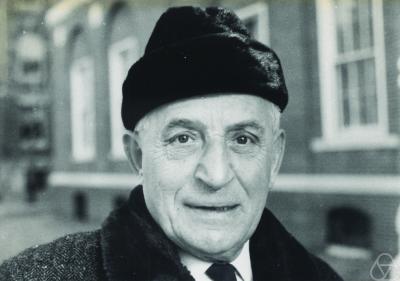<Back to Index>
- Mathematician Oscar Zariski, 1899
- Architect John Russell Pope, 1874
- Chef de l' État Français Philippe Pétain, 1856

Oscar Zariski (born Oscher Zaritsky April 24, 1899, Kobrin, Russia (today Belarus), died July 4, 1986, Brookline, Massachusetts) was a Jewish-American mathematician and one of the most influential algebraic geometers of the 20th century.
Zariski was born Oscher Zaritsky to a Jewish family and in 1918 studied at the University of Kiev. He left Kiev in 1920 to study in Rome where he became a disciple of the Italian school of algebraic geometry, studying with Guido Castelnuovo, Federigo Enriques and Francesco Severi. Zariski wrote a doctoral dissertation in 1924 on a topic in Galois theory. At the time of his dissertation publication, he changed his name for professional purposes to Oscar Zariski. Zariski emigrated to the USA in 1927 supported by Solomon Lefschetz. He had a position at Johns Hopkins University where he became professor in 1937. During this period, he wrote Algebraic Surfaces as
a summation of the work of the Italian school. The book was published
in 1935 and reissued 36 years later, with detailed notes by Zariski's
students that illustrated how the field of algebraic geometry had
changed. It is still an important reference. It seems to have been this work that set the seal of Zariski's discontent with the approach of the Italians to birational geometry. The question of rigour he addressed by recourse to commutative algebra. The Zariski topology, as it was later known, is adequate for biregular geometry,
where varieties are mapped by polynomial functions. That theory is too
limited for algebraic surfaces, and even for curves with singular
points. A rational map is to a regular map as a rational function is
to a polynomial: it may be indeterminate at some points. In geometric
terms, one has to work with functions defined on some open, dense set of a given variety. The description of the behaviour on the complement may require infinitely near points to be introduced to account for limiting behaviour along different directions. This introduces a need, in the surface case, to use also valuation theory to describe the phenomena such as blowing up (balloon-style, rather than explosively). Zariski became professor at Harvard University in
1947 where he remained until his retirement in 1969. In 1945, he
fruitfully discussed foundational matters for algebraic geometry with André Weil.
Weil's interest was in putting an abstract variety theory in place, to
support the use of the Jacobian variety in his proof of the Riemann hypothesis for curves over finite fields, a direction rather oblique to Zariski's interests. The two sets of foundations weren't reconciled at that point. At Harvard, Zariski's students included Shreeram Abhyankar, Heisuke Hironaka, David Mumford, Michael Artin and Steven Kleiman — thus spanning the main areas of advance in singularity theory, moduli theory and cohomology in the next generation. Zariski himself worked on equisingularity theory. Some of his major results, Zariski's main theorem and the Zariski theorem on holomorphic functions, were amongst the results generalized and included in the programme of Alexander Grothendieck that ultimately unified algebraic geometry. Zariski proposed the first example of a Zariski surface in 1958.
Zariski was awarded the Steele Prize in 1981. He wrote also Commutative Algebra in two volumes, with Pierre Samuel. His papers have been published by MIT Press, in four volumes.